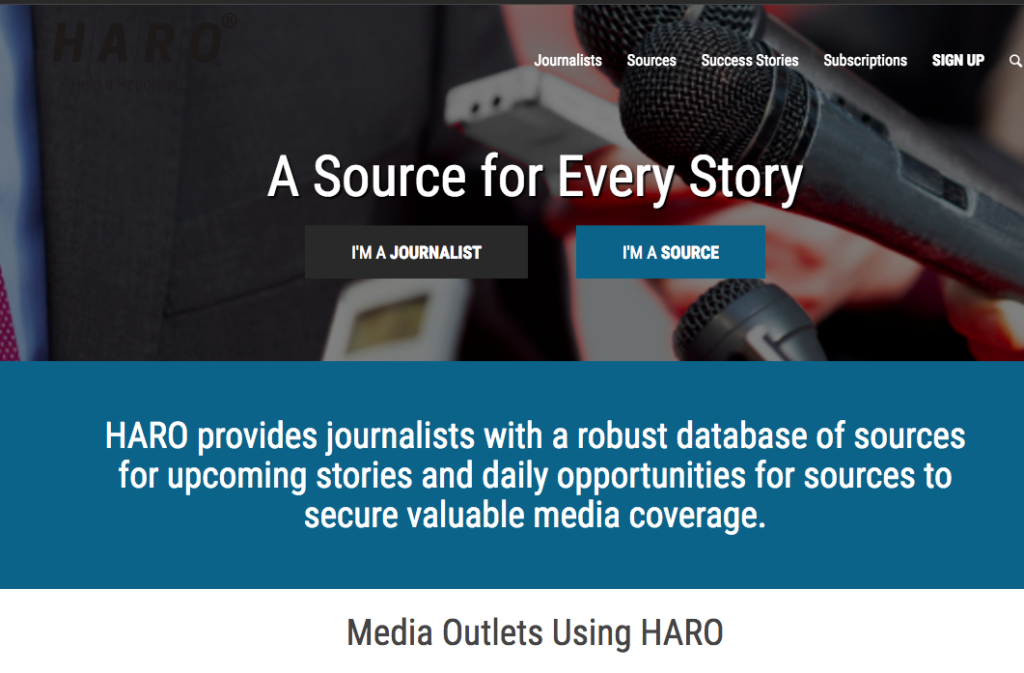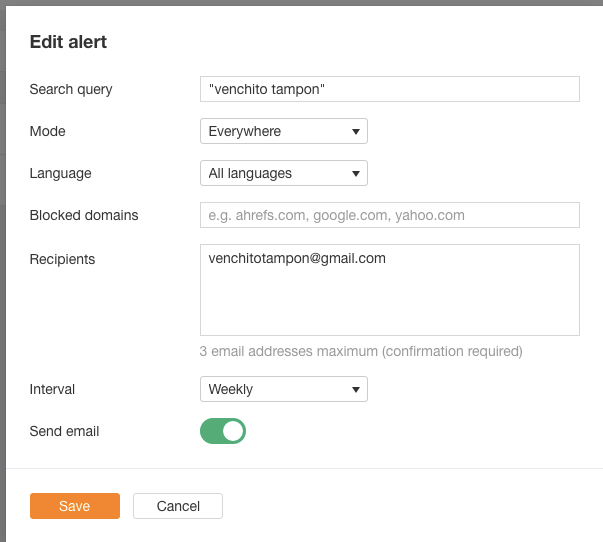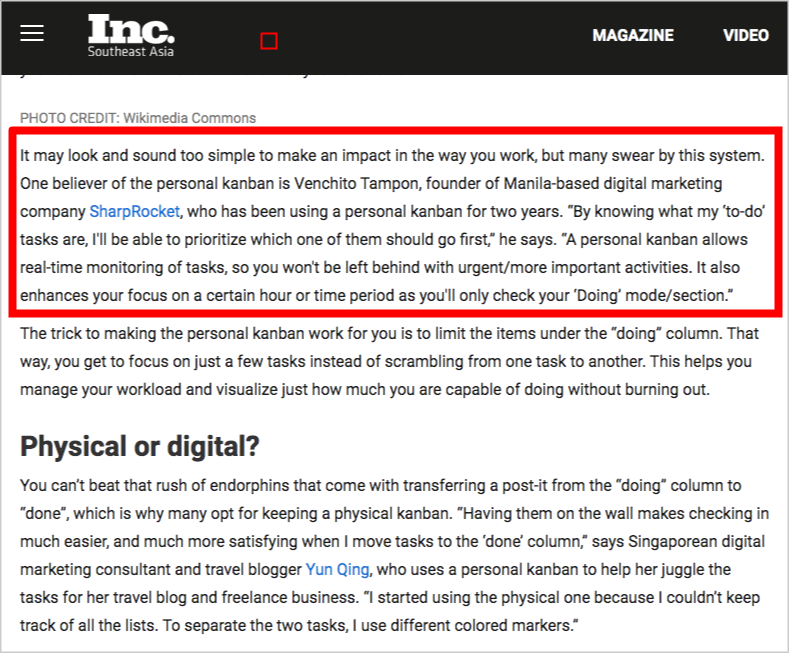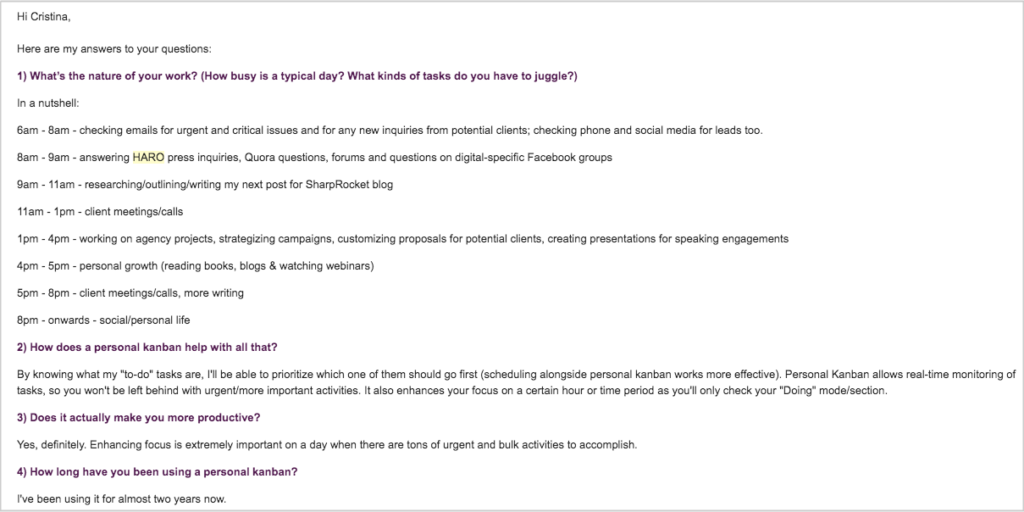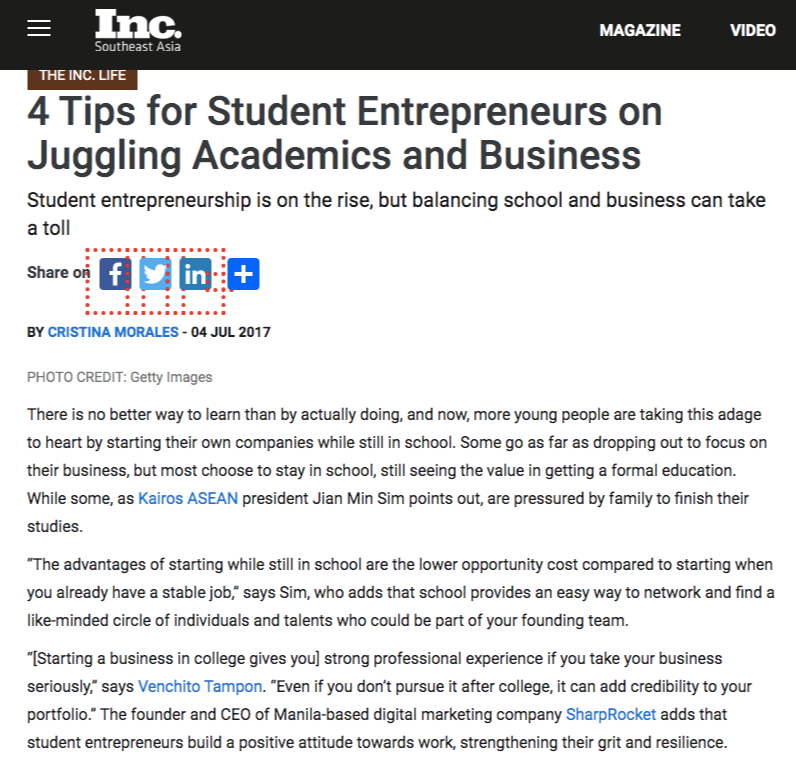by Venchito Tampon Jr | Last Updated on July 10, 2023
What is HARO?
Help a Reporter Out (known as HARO) is a free service that connects journalists and publishers to content contributors with the aim of securing valuable media coverage for brands and individuals.
If you are a brand looking for publicity, don’t look further than HARO. It has a lot of benefits that you could never imagine only spending 30 minutes to 1 hour a day.
Benefits of Using HARO
1. Free service
HARO is a must-try for you if you’re looking for ways to promote your brand without spending much on high-priced tools.
Its premium features allow more filtering and offer more opportunities to maximize your strategy of using it, but HARO’s free service is a good start for new and established brands.
2. Easy to respond
Many available platforms connect you to publishers and journalists, but most will require you to participate inside the platform.
There’s nothing wrong with it, especially if you’re trying to put all campaigns in one place. However, if you’re only working on one site, you want the flexibility of communicating with the publishers at your own pace.
HARO can easily send story requests straight to your emails. You can reply to them either you’re on desktop or mobile.
3. Personal branding and thought leadership
Personal brand, as originally coined by Tom Peters in a Fast Company article, “The Brand Called You“, are figuring out how to transcend the narrow boundaries of their categories and become a brand surrounded by buzz. He forecasted that human beings would think of themselves as a unique product.
If you can personally put your brand ahead by showcasing your expertise on a subject matter, HARO gives you a way to do that.
Knowing the subject matter and being known for it are two different things. Through journalists’ requests for questions to be answered, you are hitting two birds with one stone: getting more exposure and targeting an audience your brand can offer (servicing their needs).
4. Social proof
Getting featured in top publications in your vertical can be used as social proof on your website. Whether it’s a logo you can include on the most visible sections of your homepage or use it as additional credibility to your guest posting portfolio, both give leverage to push your brand further out there.
How Does HARO Work?
Sign up as a source.

After you sign up, you’ll get three emails a day — scheduled at 5:35 a.m., 12:35 p.m., and 5:35 p.m., ET from Monday to Friday.
Those emails come from journalists requesting additional content contributions, interviews, and even quotes for stories they are working on.
You, as a source, respond to their requests, and these journalists will respond to you if they find your response fits their needs.
Finally, you get featured in their publications.
How to Use HARO For Backlinks?
Many people overcomplicate the process to use, but the reality is that it’s not that hard.
Here’s how to use HARO in four simple steps:
- Choose relevant topics.
- Set up emails through filters.
- Set up IFTTT for important requests.
- Choose relevant HARO inquiries.
Choose relevant topics
To maximize the use of HARO, choose topics only relevant to your brand. Don’t waste time trying to pursue topics you don’t have expertise in.
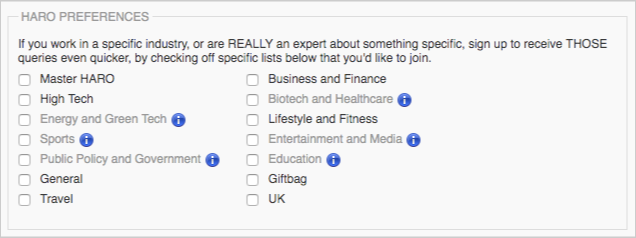
Checkboxes of industries where you can highly participate in content contribution. You may be tempted to check all, but it will only add clutter to your HARO emails.
I highly recommend only choosing one or two that best fit your site. If you’re an agency, it’s no doubt you choose all for your clients — and only filter the emails based on categories and expertise once they arrive.
Setup emails through filters
Once you properly set up your emails, you’ll receive emails listing journalist HARO queries connected to your topics.
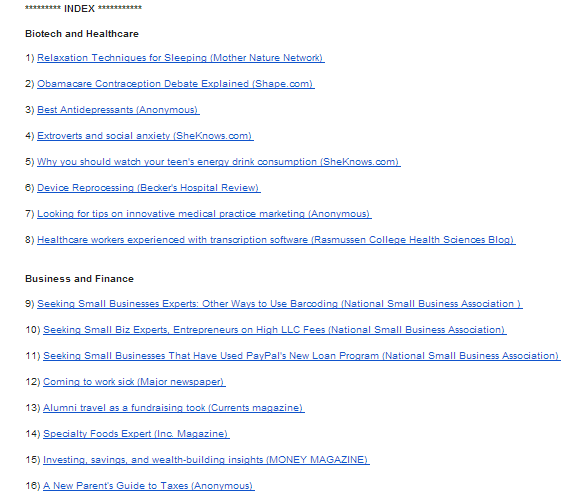
Furthermore, create filters for all emails ‘from:haro@helpareporter.com’ inside your inbox. Here are the filter options you can use:
- Apply the label — label a category to HARO emails as soon as they arrive, so you can quickly prioritize them at times (particularly if you’re getting hundreds or thousands of emails).
- Never send it to spam – it prevents any HARO email from getting caught in your spam filter.
- Categorize as Primary — to quickly transfer those HARO emails to your inbox’s Primary Tab.
Setup IFTTT for important requests
To ensure you can respond to important requests, you can set up IFTTT (If This Then That) to update you quickly whenever there are new HARO requests.
The advantage of doing so is that you can respond immediately to email requests while on mobile. It works best for people outside the US/UK timezone, as you can do the HARO strategy even while away from the office.
If you want to use more of the technique, here are some IFTTT tricks to help you with semi-automation activities.
- Create an Applet to get an SMS sent to your cell phone whenever you receive an email from a HARO inquiry focused on a specific topic.
- Craft a draft email response in your notes so that when you receive an SMS alert of a new HARO inquiry, you can simply replace a few fields in your response template and send it to the journalist as quickly as possible.
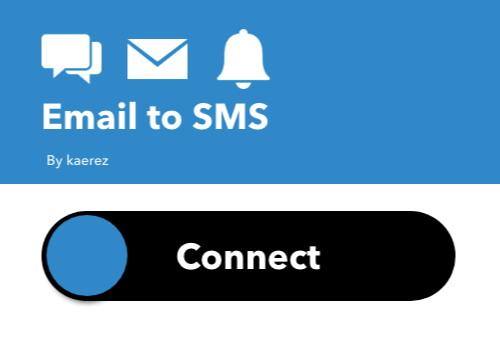
Those IFTTT initiatives can help you to stay on top of PR requests.
Choose relevant HARO inquiries
Scan your HARO emails quickly. Choose inquiries that are most relevant to your small businesses. Look at categories such as Business and Finance.
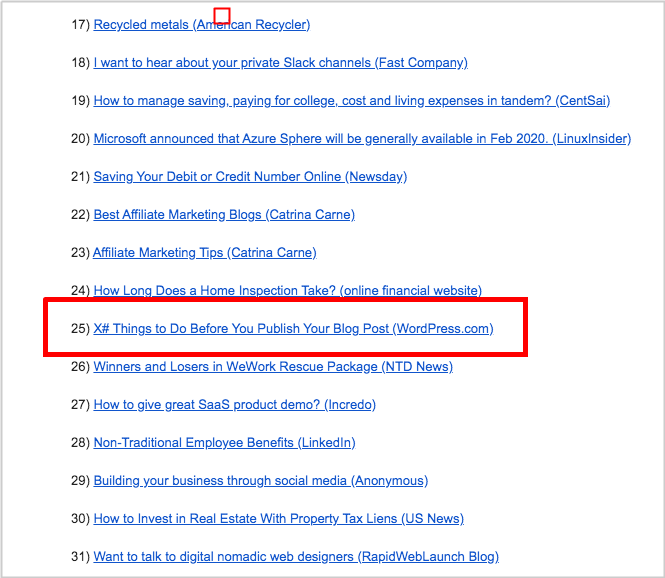
That’s why it’s important to identify your (or your brand’s) expertise, given that it’ll be easy to make choices when reading HARO emails.
Next, the most difficult part of this HARO strategy is writing pitches that work.
How to Write a HARO Pitch That Works
Needless to say, journalists receive several responses for HARO pitches.
Like you, brands, agencies, and individuals are ready to send their replies as soon as they can.
But you can’t simply send quick emails without thinking about your content properly. You may end up pitching tens of emails daily without getting much return from the strategy (i.e. contextual links).
You can’t shortcut our response to an inquiry.
Here are some tips for writing a HARO pitch that works effectively:
- Get in early.
- Read the instructions carefully.
- Make subject lines relevant and clear.
- Write a concise email.
- Send appropriate attachments, quick bio, and headshot
- Build a mutually-beneficial relationship
- Seek out freelance journalists
1. Get in early
This tip should be first in line.
You can craft a highly effective HARO pitch, but if it’s done 24 hours after you receive the HARO email pitch, you won’t get much success with it.
Timing is important. Respond as quickly as possible to HARO emails. Your response time should be as 30 minutes as possible.
However, make sure you deliver a good-quality response. It won’t cut if it’s just an early response yet a crappy contribution.
2. Read the instructions carefully
In most cases, journalists or publishers, whether from big publications like Mashable, Wall Street, or New York Times or from a niche authority publisher, provide explicit instructions to follow. These include what type of content they need you to submit, what they’re actually looking for in a contributor, and even what not to do.
It’s important to read those instructions before jumping to write your email.
3. Make subject lines relevant and clear
For example, if a HARO lead is a journalist writing a blog post about “personal kanban productivity”, your email subject should be as straightforward as this one: HARO: Personal Kanban Productivity.
You want to make sure your email subject line is 100% relevant. This will cut through the noise of other responses to that same HARO inquiry. The same principle applies to every other outreach campaign, like blogger outreach.
4. Write a concise email
The last thing you want to do is to craft an email that’s worth 10 minutes of time to read.
The key to writing a HARO pitch that works is to keep it short.
First, do not promote yourself in the email – you can add it later. But don’t start your email with a full background of yourself and what you do.
And don’t ask for links very quickly. I’ll discuss later how you’d ensure links from your quoted contribution. But for now, focus on the value of your contribution.
The simplest way to concise your email is to write 2 to 3 bullet points with data that would help the journalist on the article he/she is writing.
Focus on the goal of being quoted as a source in the article. Publishers and journalists don’t come into HARO and ask for an entire article — remember. They’re looking for a tip, data, or a short-form text for the content piece they’re creating.
Here is an email template from ____ that you can play around with—split test repeatedly depending on your needs.
Hi [Journalist’s Name],
My name is [Your Name], [short bio]. Here is _____________________:
1-2 sentences.
1-2 sentences.
1-2 sentences.
I’d love to talk more and help you with your article. Just drop me a line at [your email] or [mobile number].
– [Your Name]
Keys to success:
- No overpromotion in the first contact. By offering much help in the first place, you can instantly build a rapport and get returns in the long run (more on this later in the relationship-building part).
- A quick introduction is important, like any kind of email.
- Send a succinct content contribution to a HARO inquiry. Write exactly how you want it to appear in the article.
- A contact end line at the end of the email address helps the publisher to contact you immediately if there’s any revision he/she needs in your quote and wants more of you to discuss what you contributed.
5. Send appropriate attachments, a quick bio, and a headshot
This is the moment you can’t be aggressive with follow-ups.
Remember, HARO journalists get a gazillion requests for including short content all the time. It may take a while before they respond to your HARO pitch.
But once you receive a response from them, they may ask you for any appropriate attachment, a quick bio of yours/your brand, a headshot, and additional contact information to the content you’ve contributed.
A good recommendation is to upload your headshot to your website or Imgur and simply send them a link in your HARO response instead of attaching it to the email.
6. Build a mutually-beneficial relationship
Achieving success with your HARO pitches can be repeated as long as you can deliver good content to the same journalist.
Build relationships with publishers. Ask them gently to get back to you if there’s another opportunity to work together.
Tell them you are open to working with them and providing all the details they need.
Don’t just contact them when you want something — find something useful first relevant to what they want to write about and send it to them.
Build trust more than just getting a link.
You can check out this guide on the best email outreach tips to further enhance your relationships with publishers.
7. Seek out freelance journalists
You would find journalists doing freelance work — these are the ones who write for several different publications simultaneously. They have ongoing relationships with different publishing sites and have a huge network of content creators they partner with.
If you can connect to these people, you’ll have a chance to acquire more inbound links from their connected sites.
One good way to leverage this strategy is to set up alerts for any new articles written by freelance journalists you’ve engaged with.
Start sharing their latest articles on social media and comment on their content as soon as it is published. This initiative would help you put it on their radar and increase the chances of getting more HARO opportunities.
You may sometimes share new content ideas with them via email or add additional input. This is a perfect way to follow up with them and potentially acquire editorial link or a social share.
What do you do next when you don’t get a response from your HARO lead?
Monitor your HARO placement.
How to Monitor Your HARO Placement
You won’t always get a response from your HARO journalist — so the best way to stay on top and identify if you get a mention or your quote gets cited in an article is to monitor your link placements.
You can use Google Alerts or Ahrefs alerts to keep track of the quoted person/brand you’ve included in your HARO pitch. It’s important to remember what you’ve included in your contribution as a contributor — that will be the element you’ll be monitoring.
HARO Link Building In Action
This guide will not end without a short case study of how I do it as part of our digital PR services.
The process I’ve shared is exactly the same workflow I followed to get a contextual link from Inc. Asia:
So here’s how it started.
I signed up for HARO, chose preferred topics that I’d like to contribute to HARO requests, and scanned daily emails.
Then I stumbled upon this HARO inquiry. It perfectly fits my background – an ASEAN entrepreneur and someone who loves productivity at best.
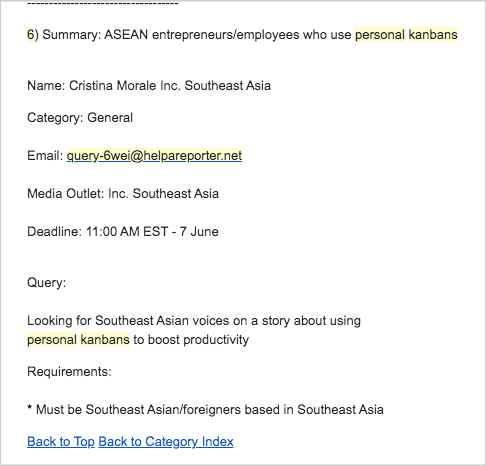
I respond quickly with a short and concise response. As you can see below, there aren’t any bullet points yet, as there is no instruction or direct questions from the inquiry. So this is an exemption to the rule of adding bullet points. Always check the instructions if these are included in the HARO inquiry.

Then I received a response from the journalist – asking me questions.
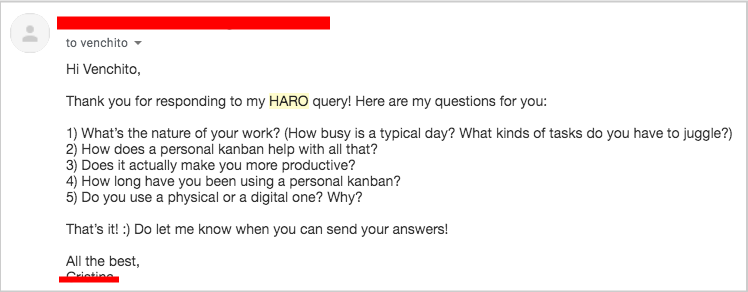
Without a doubt, I submitted my response – quite lengthy as it answers 5 questions.
Here’s where I’ll stop for a moment.
I got the link already, but there’s another opportunity for another backlink. You may also want to set up a Google alert to monitor your mentions.

To make the long story short, I submitted another response to her next questions and got another link.
Keys to success:
- Respond quickly as as you can.
- Be straightforward to send your response.
- Build relationships with the journalist/s – you might get another feature in his/her story.
Advanced HARO Tips
We’ve covered how to write a HARO pitch that works. You’ll have to start from there and test it by changing elements to keep it short yet adding more value to the journalist you’re pitching to.
There are techniques you can test out yourself that will add incremental success to your HARO strategy.
Here are some advanced HARO tips you can apply directly to your campaign.
Request for homepage links
If you get a link in your mention for your contribution, you are extremely happy with it, especially if it’s from a high publication site.
You get a contextual link, but having a link to your homepage isn’t amazing.
There is one way to do that: request a homepage link.
It may be easy as it sounds, but you have to look at what types of content you have suggested to be included in your HARO pitch. You need to have a good reason for a link to a homepage.
If contextual fits, such as group interviews, quotable mentions, and the like, getting a link to a homepage link isn’t much to ask. Looking at it from a reader or user perspective is more natural. If they want to know more about the brand or who quotes the tip, then they would simply click on the homepage link and see more details.
Respond via Twitter
There are times when there is an instruction in a HARO inquiry to connect via Twitter.
If you choose to respond via Twitter, email them so they can contact you directly, or you can offer to DM their details.
This kind of initiative speeds up the back-and-forth process of communication.
Send content that requires less editing
When responding to HARO inquiries, always be mindful of your journalist.
You want him/her to spend less time editing your content. Do the content legwork for him or her. He or she should easily plug what you’ve contributed to their articles.
Given that, if your short-form content piece isn’t quite fit, it could be a lost opportunity.
Use a compelling angle in the introduction
Many HARO pitches will have a templated introduction of what they do or what their company does.
While that may work if it’s the right fit for what the journalist is looking for, I suggest you find a compelling angle relatable to their current inquiry.
This way, you’re telling the journalist you deserve the quote, as you know about it. Don’t mention links at all
Most journalists are irritated with people asking for links when they haven’t contributed much value to their HARO pitches.
Don’t worry. You can ask for a link after your short-form content has been approved.
But during the engagement, stay focused on the value of your HARO pitch.
What You Get With HARO Paid Accounts
The first advantage of subscribing to a paid account in HARO is that you can set up your own profile or bio — which can be included in your pitches.
Though you can do it quickly with your free account, your bio that includes your website URL and your social media profiles, when easily plugged in straight to your pitch, can lessen the time adding it to your email every time you respond to inquiries. This saves you enough time for crafting emails.
Another good thing with HARO paid account is that you can add details related to the specific areas of your expertise and any previous publications in which your brand has been featured.
Moreover, with a paid subscription, you can set up alerts for HARO requests that match the specific keywords you prefer. You may even get SMS alerts if you’re in the US.
Many extra features with paid HARO accounts can help you secure more media mentions for your brand.
Passive Way of Acquiring Links
Using HARO may not always give you what you want, such as links from mentions, but if you’re doing link building, the strategy is worth the investment of your time.
All it takes is for you to respond to 4 to 5 targeted leads a day to get press. You spend only 15 to 30 minutes crafting a relevant and value-adding message for each HARO inquiry.
Have you succeeded in using HARO as one of your techniques to secure media outlet mentions? Share some tips that work for you in the comment section below.
How to Use HARO For Backlinks FAQs
Is HARO good for link building?
Yes, HARO is a powerful link building tool, especially for beginners. Despite lower conversion rates, the provided backlinks offer significant traffic and link equity benefits, fueling long-term business growth.
What is a HARO backlink?
A HARO backlink refers to a backlink obtained through the platform Help a Reporter Out (HARO). It is a valuable source for connecting with authoritative websites, gaining quality links, and organic referral traffic. HARO offers a safe, trustworthy, and cost-effective (free) method for building natural backlinks.
How do you use HARO as a source?
To use HARO as a source, sign up for the service and regularly browse the queries from journalists. Respond to relevant queries with thoughtful and concise pitches, showcasing your expertise and providing valuable insights. If your response is chosen, you’ll receive media coverage and potential backlinks to your website. Stay active, consistent, and focused in your responses to increase your chances of success with HARO.
What is HARO technique for SEO?
The HARO technique for SEO, also known as Help A Reporter Out, is a service that connects journalists and bloggers with subject matter experts. Journalists and bloggers submit queries, and subject matter experts provide input. This technique helps increase visibility and credibility by being featured in media outlets and gaining backlinks. It improves SEO by enhancing website authority and driving organic traffic.
How to work with HARO?
To work with HARO for PR link building in SEO, start by signing up for a free account on their website. Once registered, regularly check your email for HARO’s daily queries from journalists and bloggers relevant to your expertise. Respond to these queries with valuable insights and include links to your website or blog for backlink opportunities. Consistency and relevancy are key to successful HARO link building.
How to be successful with HARO?
To be successful with HARO, follow these 10 tips:
- Research the reporter’s previous work.
- Craft a concise and compelling pitch.
- Personalize your message.
- Provide valuable insights or data.
- Respond promptly.
- Be concise and clear.
- Include your credentials or expertise.
- Use bullet points or numbered lists.
- Follow up politely.
- Build relationships with reporters.
By implementing these strategies, you can increase your chances of success with HARO.
What is the purpose of HARO?
The purpose of HARO, or Help A Reporter Out, is to connect journalists and publishers with story sources. It is a platform where journalists can request subjects for their articles if they struggle to find suitable sources. HARO helps facilitate this connection, making it easier for journalists to find the information and subjects they need for their stories.
How do you respond to HARO?
When responding to HARO (Help a Reporter Out), make sure to personalize your pitch, be concise, and provide valuable insights. Highlight your expertise and provide specific examples to stand out. Furthermore, craft a catchy subject line and adhere to the journalist’s deadline for a higher chance of getting featured in their article. Following these tips can increase your chances of success with HARO responses.
The Author
Venchito Tampon Jr
Venchito Tampon is a Filipino Motivational Speaker, Corporate Trainer, and a Leadership Speaker in the Philippines. He is the CEO and Co-Founder of SharpRocket, a link building agency. With a decade of experience, Venchito has a proven track record of leading hundreds of successful SEO (link builidng) campaigns across competitive industries like finance, B2B, legal, and SaaS. His expert advice as a link building expert has been featured in renowned publications such as Semrush, Ahrefs, Huffington Post and Forbes. He is also an international SEO spoken and has delivered talks in SEO Zraz, Asia Pacific Affiliate Summit in Singapore, and Search Marketing Summit in Sydney, Australia. Check out his other businesses, Hills & Valleys Cafe, Blend N Sips and Saas Pursuit.
How our LINK BUILDING AGENCY builds 250 links/mo consistently using Predictable Link Building Methodology™…
- Using a SIMPLE and PROVEN system
- Using a SCALABLE strategy
- No private blog networks
- No creepy outreach emails
